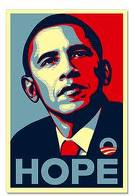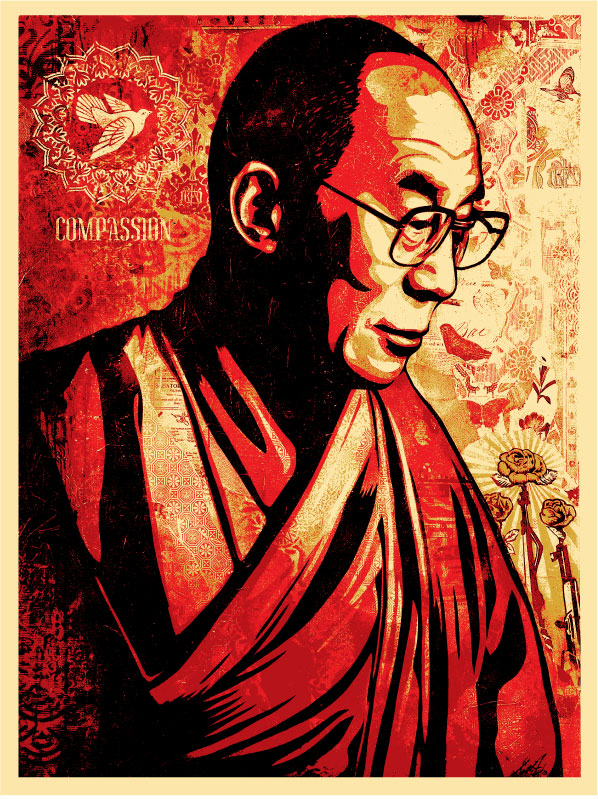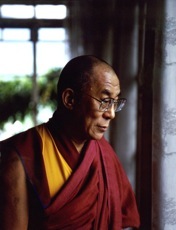It wasn't the only reason Barack Obama won the presidential election, but the fact that the original now resides in the Smithsonian gives you some indication as to the important role the then-ubiquitous and now-iconic Shepard Fairey poster had to have played. 
It is safe to say that Fairey's HOPE image will forever be embedded in our collective consciousness as emblematic of a moment in politics when change was in the air.
Fairey's distinctive take -- is it art or is it propaganda? -- is an idiosyncratic blend of Chinese propaganda mixed with elements of street art with his skateboard culture roots often clearly showing. His penchant for controversy is also part of the mix. Fairey is still embroiled in a copyright dispute with the Associated Press -- which wants credit and compensation for a specific image of Obama upon which his work is based, (Fairey's take on the issue was published previously here on the Post), and it should be noted that in the court of public opinion, Fairey has long been convicted of turning graffiti culture into a self-promoting ad campaign.
After reading, also in the Huffington Post, of a human rights activists' delight upon seeing Fairey's distinctive take on Burmese dissident leader Aung Sang Suu Kyi, and his certainty that his Freedom to Lead image would embed her story in the public consciousness, I began to imagine a similar portrait of the Dalai Lama as a fundraiser for Tibet-related causes (full disclosure: one of them is the non-profit that sponsors, "The Tibet Connection," a public radio program I also work on). From the moment I had the idea to the day I held a print of that "Compassion" portrait in my hands was a little over a year. Obviously this time Fairey wanted the photo he used as the basis to be cleared beforehand and -- thanks to a generous collaboration with longtime Dalai Lama photographer Don Farber -- we were able to give him several images to choose from.
and his certainty that his Freedom to Lead image would embed her story in the public consciousness, I began to imagine a similar portrait of the Dalai Lama as a fundraiser for Tibet-related causes (full disclosure: one of them is the non-profit that sponsors, "The Tibet Connection," a public radio program I also work on). From the moment I had the idea to the day I held a print of that "Compassion" portrait in my hands was a little over a year. Obviously this time Fairey wanted the photo he used as the basis to be cleared beforehand and -- thanks to a generous collaboration with longtime Dalai Lama photographer Don Farber -- we were able to give him several images to choose from.
The result is now part of an exhibition of his newest work opening today at Deitch Projects.
Just before he left for New York, I met with Fairey in his LA studio to find out why the picture he chose was an unusual choice, why his take is now featured alongside portraits of Bob Dylan, and John and Yoko Lennon, and what he has to say about his detractors.
CS: What drew you to the image you ultimately chose to use as a basis for the Compassion portrait?
SF: The peacefulness and thoughtfulness of it.  In a lot of my work what I am trying to convey with the subjects is an introspection, an analysis, and a social conscience, whether it's Muhammad Ali, Neil Young, or John and Yoko. With my art, what I try is -- as much as possible -- to amplify what I think a person's essence is to put a brighter spotlight on reality.
In a lot of my work what I am trying to convey with the subjects is an introspection, an analysis, and a social conscience, whether it's Muhammad Ali, Neil Young, or John and Yoko. With my art, what I try is -- as much as possible -- to amplify what I think a person's essence is to put a brighter spotlight on reality.
CS: The photographer, Don Farber, told us he is especially pleased that you chose that particular image from the several we initially gave you. He told us that as he was taking that photo, he was talking to the Dalai Lama about his own wife who is Tibetan and what her family has gone through.The Dalai Lama was looking out the window and pondering what Don was telling him. Don distinctly remembers feeling what he called "waves" of compassion at that moment, so for you to select it as a reference for your portrait is very fitting.
SF: Because he wasn't looking directly into the camera, it would not be everyone else's first choice, but it was mine. I've read about Don and I know he's been working with the Dalai Lama for many years,so far more than I would know what would be a special moment, it's great that he [agrees].
CS: What I especially appreciate is that you've created an image that transcends propaganda and is uniquely suited to highlight two very different aspects of the Dalai Lama. On the one hand he is a political figure and on the other a highly spiritual leader. That dual stance is echoed in the peaceful almost whimsical images you chose to overlay on an otherwise staid portrait.
SF: I think a lot of times the subject themselves will end up giving the viewer the feeling that it is propaganda or not propaganda. The Dalai Lama has very few chinks in the armor, I mean it's hard to find a negative angle about the guy! So taking what I thought were positive symbols and incorporating those -- especially the Chinese propaganda image with the guns that added flowers to like the Vietnam protesters did to the guns of the National Guard -- really reflect his spirit. Taking this symbol of aggression and hostility and it turning into something about peace [is like] the Dalai Lama himself; he seems to absorb anger and reflect back peace. I don't feel like there is a lot brilliance in anything I did. All I did was take things that seem very obvious and do them in a way I thought looked nice.The layering works is an way similar to a Rorschach test -- we each see a little of what we want to see. We digest on our own terms... One of the differences between art and propaganda is that propaganda leaves no latitude for interpreting and personalizing. Art has more breathing space; you don't feel like you are forced to accept one specific point of view.
CS: Take me through the process from choosing the image to creating that final print.
SF: First I take the photograph and I start to look at it at different contrast levels in Photoshop. My process is a reductive process, and what I'm trying to do is keep the things I think are powerful and strip away the superfluous. Then once stripped I can add back little things that enhance but don't distract. In Photoshop I decide if I'm going to make it a three color image-- all my technique came out of screen printing or stenciling, because those were my production methods and still are for the most part. I remove details in some areas then I illustrate each of those three colors by hand, scan those back into the computer, and then see, once they are re-overlaid, if they're achieving what I want to. If they are not, I do more manipulating to create a more refined digital sketch. Then I do a next wave of digital sketch which is closer to what the end product will be and then I get into collage and texture. I also go back and do a little bit of traditional painting too. Then I decide what size I'm going to make it and I make stencils, block on canvas where the figure is going to fall, and then decide where I'm going to put elements like birds flowers or different decorative patterns or newspaper clippings. Then I'll start painting the image with the stencil,. It's steps of constantly editing and refining. I don't think its super different from what you would get if you combined a Rauschenberg and a Warhol -- not that I claim to be of their stature, but the techniques they used influence me. It's also little bit haphazard; happy accidents [are part of] my process.
CS: Is what you did for the Obama campaign and this one becoming a business model or a trademark of yours? Will you continue donating a visual representation to causes and organizations you feel are important?
SF: I wish it was all just about charity! This idea that you do this for money over here and for charity over there? I look at it as very intertwined -- hey, that's Buddhist thing, right? -- I started to care about social causes because of people like Bob Marley, Bob Dylan and Noam Chomsky. A lot of it was through music, then I started to pay attention to politics in general and the idea that you can create something people respond to on visceral level....whether it's music you listen to or art you look at but then there can be the layer of an educational component and a positive sort of social commentary to the piece. I look at the Dalai Lama or any number of people or causes as an opportunity for me to make an image that is powerful and striking and satisfies my creative urges in a purely aesthetic way. There have been people who are cynical and jaded and say I just hijack every cause and re-brand it to make money off it (laughs). If I just wanted to make money there are a lot of other things I could be doing. You can entertain and engage people in a capitalist consumer culture way but also put your cultural currency and literal currency into things you care about and sort of help everybody. It's a win/win thing.
CS: Tell me about your new show.
SF: The show is called May Day. May Day has a history of being sort of a spring rebirth, and there is lots to celebrate in terms of rebirth, we have a have a new black president! Also since the Haymarket massacre, it's also had a workers rights connotation, and finally, May Day is also a distress signal. There's the current disparity in wealth, the shrinking middle class, and the two party system is now completely dysfunctional. So I'm bringing together a lot of strands of things I care about. The portrait of His Holiness really fit in with those things I wanted to deal with in the show.
CS: Responses to the Compassion portrait?
SF: [The first run] sold out right away ( in 7 minutes!) People love the print and are still asking if they can get it anywhere other than eBay. A lot of people said I did a lot of their other heroes and they were glad I got around to the Dalai Lama. It's all been very positive, not one negative thing, and that's pretty rare!
Fairey's New York show runs through May 29 at Deitich Projects.
You can hear more of my interview with Shep Fairey at: http://www.thetibetconnection.org/